Recycling of Contaminated Marine Sediment and Industrial By-Products through Combined Stabilization/Solidification and Granulation Treatment
Abstract
:1. Introduction
2. Materials and Methods
2.1. Framework of the Experimentation
2.2. Contaminated Marine Sediments
2.3. Geopolymers Precursors and Activator Solutions
2.4. Composition and Microstructural Analysis
2.5. S/S Testing and Granule Characterization
3. Results
3.1. Contaminated-Marine-Sediment Characterization
3.2. Characterization of Geopolymers’ Precursors
3.2.1. Coal Fly Ash
3.2.2. Blast Furnace Slag
3.3. S/S Performance and Granule Characterization
4. Discussion
5. Conclusions
Author Contributions
Funding
Data Availability Statement
Acknowledgments
Conflicts of Interest
References
- Todaro, F.; Barjoveanu, G.; De Gisi, S.; Teodosiu, C.; Notarnicola, M. Sustainability assessment of reactive capping alternatives for the remediation of contaminated marine sediments. J. Clean. Prod. 2021, 286, 124946. [Google Scholar] [CrossRef]
- Abdel-shafy, H.I.; Mansour, M.S.M. A review on polycyclic aromatic hydrocarbons: Source, environmental impact, effect on human health and remediation. Egypt. J. Pet. 2016, 25, 107–123. [Google Scholar] [CrossRef] [Green Version]
- Kujlu, R.; Moslemzadeh, M.; Rahimi, S.; Aghayani, E.; Ghanbari, F.; Mahdavianpour, M. Selecting the best stabilization/solidification method for the treatment of oil-contaminated soils using simple and applied best-worst multi-criteria decision-making method. Environ. Pollut. 2020, 263, 114447. [Google Scholar] [CrossRef] [PubMed]
- Wang, L.; Kwok, J.S.H.; Tsang, D.C.W.; Poon, C. Mixture design and treatment methods for recycling contaminated sediment. J. Hazard. Mater. 2015, 283, 623–632. [Google Scholar] [CrossRef]
- Coppola, L.; Bellezze, T.; Belli, A.; Bignozzi, M.C.; Bolzoni, F.; Brenna, A.; Yang, F. Binders alternative to Portland cement and waste management for sustainable construction Part 2. J. Appl. Biomater. Funct. Mater. 2018, 16, 207–221. [Google Scholar]
- Petrella, A.; Spasiano, D.; Rizzi, V.; Cosma, P.; Race, M.; De Vietro, N. Lead ion sorption by perlite and reuse of the exhausted material in the construction field. Appl. Sci. 2018, 8, 1882. [Google Scholar] [CrossRef] [Green Version]
- Wang, D.; Abriak, N.E.; Zentar, R. Strength and deformation properties of Dunkirk marine sediments solidified with cement, lime and fly ash. Eng. Geol. 2013, 166, 90–99. [Google Scholar] [CrossRef]
- Couvidat, J.; Benzaazoua, M.; Chatain, V.; Bouamrane, A.; Bouzahzah, H. Feasibility of the reuse of total and processed contaminated marine sediments as fine aggregates in cemented mortars. Construct. Build. Mater. 2016, 112, 892–902. [Google Scholar] [CrossRef] [Green Version]
- Messina, F.; Ferone, C.; Molino, A.; Roviello, G.; Colangelo, F.; Molino, B.; Cioffi, R. Synergistic recycling of calcined clayey sediments and water potabilization sludge as geopolymer precursors: Upscaling from binders to precast paving cement-free bricks. Constr. Build. Mater. 2017, 133, 14–26. [Google Scholar] [CrossRef]
- Rizzi, V.; D’Agostino, F.; Gubitosa, J.; Fini, P.; Petrella, A.; Agostiano, A.; Semeraro, P.; Cosma, P. An alternative use of olive pomace as a wide-ranging bioremediation strategy to adsorb and recover disperse orange and disperse red industrial dyes from wastewater. Separations 2017, 4, 29. [Google Scholar] [CrossRef] [Green Version]
- Tsang, D.C.; Olds, W.E.; Weber, P.A.; Yip, A.C. Soil stabilization using AMD sludge, compost and lignite: TCLP leachability and continuous acid leaching. Chemosphere 2013, 93, 2839–2847. [Google Scholar] [CrossRef]
- De Gisi, S.; Todaro, F.; Mesto, E.; Schingaro, E.; Notarnicola, M. Recycling contaminated marine sediments as filling materials by pilot scale stabilization/solidification with lime, organoclay and activated carbon. J. Clean. Prod. 2020, 269, 122416. [Google Scholar] [CrossRef]
- Wang, L.; Chen, L.; Tsang, D.C.; Kua, H.W.; Yang, J.; Ok, Y.S.; Ding, S.; Hou, D.; Poon, C.S. The roles of biochar as green admixture for sediment-based construction products. Cement. Concrete. Comp. 2019, 104, 103348. [Google Scholar] [CrossRef]
- Shubbar, A.A.; Jafer, H.; Dulaimi, A.; Hashim, K.; Atherton, W.; Sadique, M. The development of a low carbon binder produced from the ternary blending of cement, ground granulated blast furnace slag and high calcium fly ash: An experimental and statistical approach. Constr. Build. Mater. 2018, 187, 1051–1060. [Google Scholar] [CrossRef]
- Capobianco, O.; Costa, G.; Baciocchi, R. Assessment of the operating windows of a combined solidification/stabilization and granulation treatment applied to industrial soil in the context of brownfield regeneration. WIT Trans. Eco. Environ. 2014, 181, 577–588. [Google Scholar]
- Nakhaei, A.; Marandi, S.M.; Kermani, S.S.; Bagheripour, M.H. Dynamic properties of granular soils mixed with granulated rubber. Soil Dyn. Earthq. 2012, 43, 124–132. [Google Scholar] [CrossRef]
- Cioffi, R.; Colangelo, F.; Montagnaro, F.; Santoro, L. Manufacture of artificial aggregate using MSWI bottom ash. J. Waste Manag. 2011, 31, 281–288. [Google Scholar] [CrossRef]
- Di Palma, L.; Medici, F.; Vilardi, G. Artificial aggregate from non metallic automotive shredder residue. Chem. Eng. Trans. 2015, 43, 1723–1728. [Google Scholar]
- Ren, P.; Ling, T.C.; Mo, K.H. Recent Advances in Artificial Aggregate Production. J. Clean. Prod. 2020, 291, 125215. [Google Scholar] [CrossRef]
- Vasugi, V.; Ramamurthy, K. Identification of design parameters influencing manufacture and properties of cold-bonded pond ash aggregate. Mater. Design 2014, 54, 264–278. [Google Scholar] [CrossRef]
- Kang, X.; Bate, B.; Chen, R.P.; Yang, W.; Wang, F. Physicochemical and mechanical properties of polymer-amended kaolinite and fly ash–kaolinite mixtures. J. Mater. Civ. Eng. 2019, 31, 04019064. [Google Scholar] [CrossRef]
- Lirer, S.; Liguori, B.; Capasso, I.; Flora, A.; Caputo, D. Mechanical and chemical properties of composite materials made of dredged sediments in a fly-ash based geopolymer. J. Environ. Manage 2017, 191, 1–7. [Google Scholar] [CrossRef] [PubMed]
- Reddy, V.A.; Solanki, C.H.; Kumar, S.; Reddy, K.R.; Du, Y.J. New ternary blend limestone calcined clay cement for solidification/stabilization of zinc contaminated soil. Chemosphere 2019, 235, 308–315. [Google Scholar] [CrossRef] [PubMed]
- Roviello, G.; Menna, C.; Tarallo, O.; Ricciotti, L.; Ferone, C.; Colangelo, F.; Cioffi, R. Preparation, structure and properties of hybrid materials based on geopolymers and polysiloxanes. Mater. Design 2015, 87, 82–94. [Google Scholar] [CrossRef]
- Molino, B.; De Vincenzo, A.; Ferone, C.; Messina, F.; Colangelo, F.; Cioffi, R. Recycling of clay sediments for geopolymer binder production. A new perspective for reservoir management in the framework of Italian legislation: The Occhito reservoir case study. Materials 2014, 7, 5603–5616. [Google Scholar] [CrossRef]
- El-Eswed, B.I.; Yousef, R.I.; Alshaaer, M.; Hamadneh, I.; Al-Gharabli, S.I.; Khalili, F. Stabilization/solidification of heavy metals in kaolin/zeolite based geopolymers. Int. J. Miner. Process. 2015, 137, 34–42. [Google Scholar] [CrossRef]
- Jin, M.; Zheng, Z.; Sun, Y.; Chen, L.; Jin, Z. Resistance of metakaolin-MSWI fly ash based geopolymer to acid and alkaline environments. J. Non-Cryst. Solids 2016, 450, 116–122. [Google Scholar] [CrossRef]
- Colangelo, F.; Farina, I.; Travaglioni, M.; Salzano, C.; Cioffi, R.; Petrillo, A. Innovative Materials in Italy for Eco-Friendly and Sustainable Buildings. Materials 2021, 14, 2048. [Google Scholar] [CrossRef]
- Almadani, M.; Razak, R.A.; Abdullah, M.M.A.B.; Mohamed, R. Geopolymer-Based Artificial Aggregates: A Review on Methods of Producing, Properties, and Improving Techniques. Materials 2022, 15, 5516. [Google Scholar] [CrossRef]
- Takaluoma, E.; Samarina, T. Granulation techniques of geopolymers and alkali-activated materials. In Alkali-Activated Materials in Environmental Technology Applications; Woodhead Publishing: Sawston, UK, 2022; pp. 97–111. [Google Scholar]
- Todaro, F.; De Gisi, S.; Notarnicola, M. Sustainable remediation technologies for contaminated marine sediments: Preliminary results of an experimental investigation. Environ. Eng. Manag. J. 2018, 17, 2465–2471. [Google Scholar] [CrossRef]
- Todaro, F.; De Gisi, S.; Notarnicola, M. Contaminated marine sediment stabilization/solidification treatment with cement/lime: Leaching behaviour investigation. Environ. Sci. Pollut. Res. Int. 2020, 27, 21407–21415. [Google Scholar] [CrossRef]
- Cotecchia, F.; Vitone, C.; Sollecito, F.; Mali, M.; Miccoli, D.; Petti, R.; Milella, D.; Ruggieri, G.; Bottiglieri, O.; Corbelli, V.; et al. A geo-chemo-mechanical study of a highly polluted marine system (Taranto, Italy) for the enhancement of the conceptual site model. Sci. Rep. 2021, 11, 4017. [Google Scholar] [CrossRef]
- Vitone, C.; Federico, A.; Puzrin, A.M.; Ploetze, M.; Carrassi, E.; Todaro, F. On the geotechnical characterisation of the polluted submarine sediments from Taranto. Environ. Sci. Pollut. Res. 2016, 23, 12535–12553. [Google Scholar] [CrossRef]
- Petrillo, A.; Colangelo, F.; Farina, I.; Travaglioni, M.; Salzano, C.; Cioffi, R. Multi-criteria analysis for Life Cycle Assessment and Life Cycle Costing of lightweight artificial aggregates from industrial waste by double-step cold bonding palletization. J. Clean. Prod. 2022, 351, 131395. [Google Scholar] [CrossRef]
- Perumal, P.; Hasnain, A.; Luukkonen, T.; Kinnunen, P.; Illikainen, M. Role of Surfactants on the Synthesis of Impure Kaolin-Based Alkali-Activated, Low-Temperature Porous Ceramics. Open Ceram. 2021, 6, 10009. [Google Scholar] [CrossRef]
- Provis, J.L.; Arbi, K.; Bernal, S.A.; Bondar, D.; Buchwald, A.; Castel, A.; Chithiraputhiran, S.; Cyr, M.; Dehghan, A.; Dombrowski-Daube, K.; et al. RILEM TC 247-DTA round robin test: Mix design and reproducibility of compressive strength of alkali-activated concretes. Mater. Struct. 2019, 52, 1–13. [Google Scholar] [CrossRef]
- EN 13055; Lightweight Aggregates. iTeh: Toronto, ON, Canada, 2016.
- EN 12457-2; Characterisation of Waste—Leaching—Compliance Test for Leaching of Granular Waste Materials and Sludges. iTeh: Toronto, ON, Canada, 2002.
- EPA. EPA Method 200.8: Determination of Trace Elements in Waters and Wastes by Inductively Coupled Plasma—Mass Spectrometry; EPA: Washington, DC, USA, 1994. [Google Scholar]
- UNI 11060; Cultural Heritage—Natural and Artificial Stones. European Committee for Standardization: Brussels, Belgium, 2003.
- BS 812; Methods for Sampling and Testing of Mineral Aggregates Sands and Filters. British Standard Institution: London, UK, 1960.
- ICRAM. Values of Intervention for Sediments of Areas Strongly Anthropized with Reference to the Site of Reclamation of National Interest in Taranto; Central Institute for Scientific and Technological Research applied to the Sea: Rome, Italy, 2004. (In Italian) [Google Scholar]
- Abora, K.; Beleña, I.; Bernal, S.A.; Dunster, A.; Nixon, P.A.; Provis, J.L.; Tagnit-Hamou, A.; Winnefeld, F. Durability and testing–Chemical matrix degradation processes. In Alkali Activated Materials; Springer: Dordrecht, The Netherlands, 2014; pp. 177–221. [Google Scholar]
- Gaál, F.; Szöllősy, I.; Arnold, M.; Paulik, F. Determination of the organic matter, metal carbonate and mobile water in soils simultaneous TG, DTG, DTA and EGA techniques. J. Therm. Anal. Calorim. 1994, 42, 1007–1016. [Google Scholar] [CrossRef]
- Oudghiri, F.; García-Morales, J.L.; Rodríguez-Barroso, M.R. Evaluation of Sediments Decontamination by Chelating Agents using Thermogravimetric Analysis. Int. J. Environ. Res. 2015, 9, 657–662. [Google Scholar]
- Bensharada, M.; Telford, R.; Stern, B.; Gaffney, V. Loss on ignition vs. thermogravimetric analysis: A comparative study to determine organic matter and carbonate content in sediments. J. Paleolimnol. 2021, 67, 191–197. [Google Scholar] [CrossRef]
- Labianca, C.; De Gisi, S.; Todaro, F.; Notarnicola, M. DPSIR model applied to the remediation of contaminated sites. A case study: Mar Piccolo of Taranto. Appl. Sci. 2020, 10, 5080. [Google Scholar] [CrossRef]
- Sarkar, A.; Rano, R.; Mishra, K.K.; Sinha, I.N. Particle size distribution profile of some Indian fly ash—A comparative study to assess their possible uses. Fuel Process. Technol. 2005, 86, 1221–1238. [Google Scholar] [CrossRef]
- Wang, Z.; Cao, J.; Li, W.; Wang, Y.; Luo, G.; Qiao, Y.; Zhang, Y.; Xu, B. Using a material database and data fusion method to accelerate the process model development of high shear wet granulation. Sci. Rep. 2021, 11, 16514. [Google Scholar] [CrossRef] [PubMed]
- Siddique, R.; Cachim, P. Waste and Supplementary Cementitious Materials in Concrete; Woodhead Publishing: Sawston, UK, 2018. [Google Scholar]
- FAO. Italian Ministerial Decree Identification of not-hazardous waste subjected to simplified recovery procedures. Ital. Off. J. 1988, 16, 88. (In Italian) [Google Scholar]
- Colangelo, F.; Messina, F.; Di Palma, L.; Cioffi, R. Recycling of non-metallic automotive shredder residues and coal fly-ash in cold-bonded aggregates for sustainable concrete. Compos. B Eng. 2017, 116, 46–52. [Google Scholar] [CrossRef]
- Hattaf, R.; Benchikhi, M.; Azzouzi, A.; El Ouatib, R.; Gomina, M.; Samdi, A.; Moussa, R. Preparation of Cement Clinker from Geopolymer-Based Wastes. Materials 2021, 14, 6534. [Google Scholar] [CrossRef]
- Pan, Y.; Rossabi, J.; Pan, C.; Xie, X. Stabilization/solidification characteristics of organic clay contaminated by lead when using cement. J. Hazard. Mater. 2019, 362, 132–139. [Google Scholar] [CrossRef]
- Shi, C.; Fernández-Jiménez, A. Stabilization/solidification of hazardous and radioactive wastes with alkali-activated cements. J. Hazard. Mater. 2006, 137, 1656–1663. [Google Scholar] [CrossRef]
- Kogbara, R.B.; Al-Tabbaa, A.; Yi, Y.; Stegemann, J.A. pH-dependent leaching behaviour and other performance properties of cement-treated mixed contaminated soil. J. Environ. Sci. 2012, 24, 1630–1638. [Google Scholar] [CrossRef]
- Komonweeraket, K.; Cetin, B.; Aydilek, A.H.; Benson, C.H.; Edil, T.B. Effects of pH on the leaching mechanisms of elements from fly ash mixed soils. Fuel 2015, 140, 788–802. [Google Scholar] [CrossRef]
- De Gisi, S.; Romaniello, L.; Dalessandro, M.; Todaro, F.; Notarnicola, M. Recovery of iron rich residues from integrated steel making process by hydrated lime/molasses pressurised cold agglomeration. J. Clean. Prod. 2019, 233, 830–840. [Google Scholar] [CrossRef]
- Arfania, H.; Asadzadeh, F. Mobility of heavy metals after spiking in relation to sediment and metal properties: Leaching column study. J. Soils Sediment 2015, 15, 2311–2322. [Google Scholar] [CrossRef]
- Tigue, A.A.S.; Malenab, R.A.J.; Dungca, J.R.; Yu, D.E.C.; Promentilla, M.A.B. Chemical Stability and Leaching Behavior of One-Part Geopolymer from Soil and Coal Fly Ash Mixtures. Minerals 2018, 8, 411. [Google Scholar] [CrossRef] [Green Version]
- Zhang, J.; Provis, J.L.; Feng, D.; van Deventer, J.S.J. Geopolymers for immobilization of Cr6+, Cd2+, and Pb2+. J. Hazard. Mater. 2008, 157, 587–598. [Google Scholar] [CrossRef]
- Xu, H.; Gong, W.; Syltebo, L.; Izzo, K.; Lutze, W.; Pegg, I.L. Effect of blast furnace slag grades on fly ash based geopolymer waste forms. Fuel 2014, 133, 332–340. [Google Scholar] [CrossRef]
- Łach, M.; Korniejenko, K.; Walter, J.; Stefańska, A.; Mikuła, J. Decreasing of Leaching and Improvement of Geopolymer Properties by Addition of Aluminum Calcium Cements and Titanium Oxide. Materials 2020, 13, 495. [Google Scholar] [CrossRef] [Green Version]
- Łach, M.; Hebdowska-Krupa, M.; Komar, N. Strength and leachability of geopolymers with the addition of municipal solid waste ashes. IOP Conf. Ser. Mater. Sci. Eng. 2019, 706, 012010. [Google Scholar] [CrossRef]
- Li, Y.-Y.; Zhang, T.-T.; Jia, S.B.; Liu, J.; Quan, X.-H.; Zheng, W. Mechanical properties and leaching characteristics of geopolymer-solidified/stabilized lead-contaminated soil. Adv. Civ. Eng. 2019, 2019, 6015769. [Google Scholar] [CrossRef] [Green Version]
- Gesoğlu, M.; Güneyisi, E.; Alzeebaree, R.; Mermerdaş, K. Effect of silica fume and steel fiber on the mechanical properties of the concretes produced with cold bonded fly ash aggregates. Constr. Build. Mater. 2013, 40, 982–990. [Google Scholar] [CrossRef]
- Güneyisi, E.; Gesoğlu, M.; Mohamadameen, A.; Alzeebaree, R.; Algın, Z.; Mermerdaş, K. Enhancement of shrinkage behavior of lightweight aggregate concretes by shrinkage reducing admixture and fiber reinforcement. Constr. Build. Mater. 2018, 54, 91–98. [Google Scholar] [CrossRef]

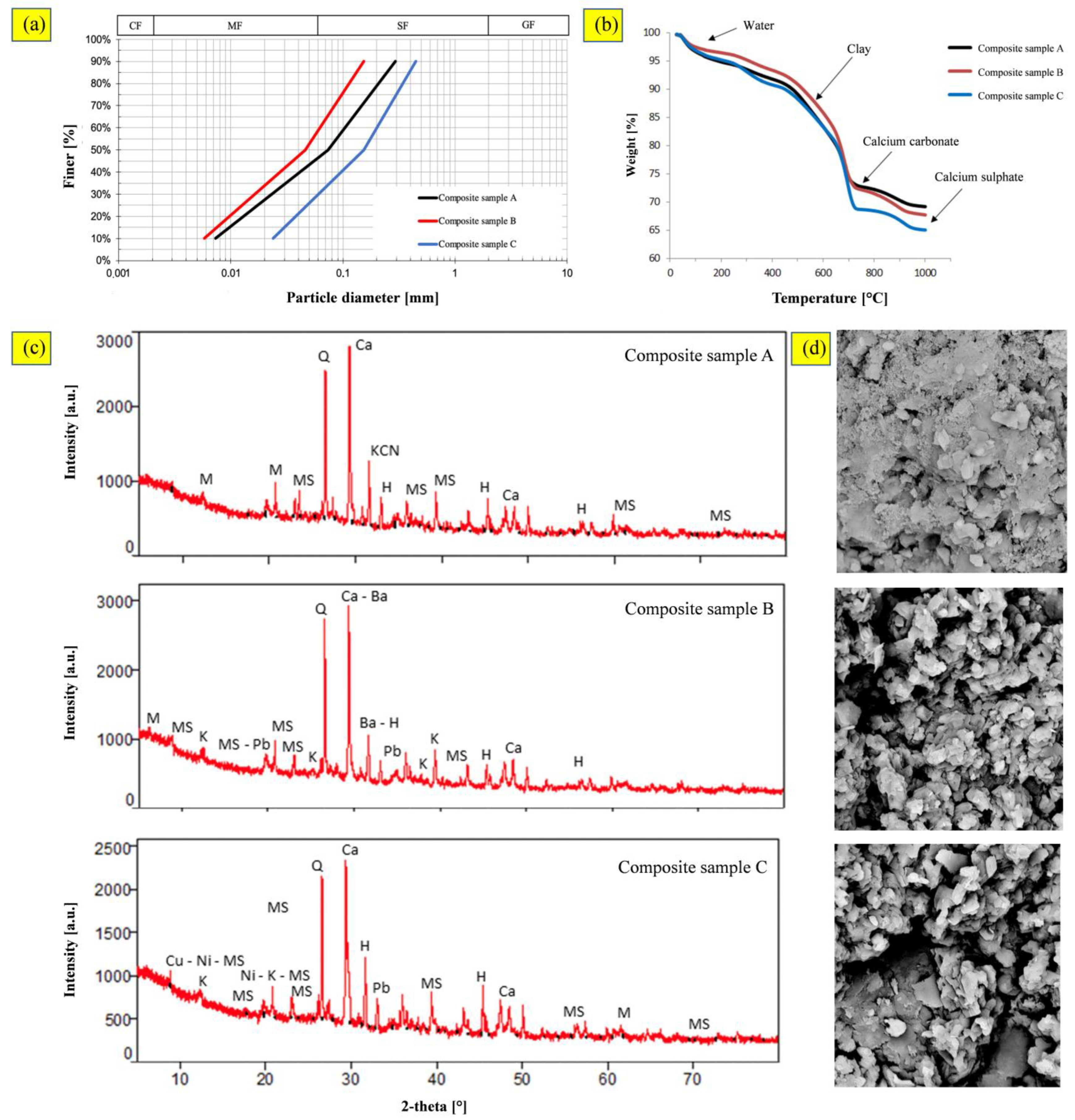
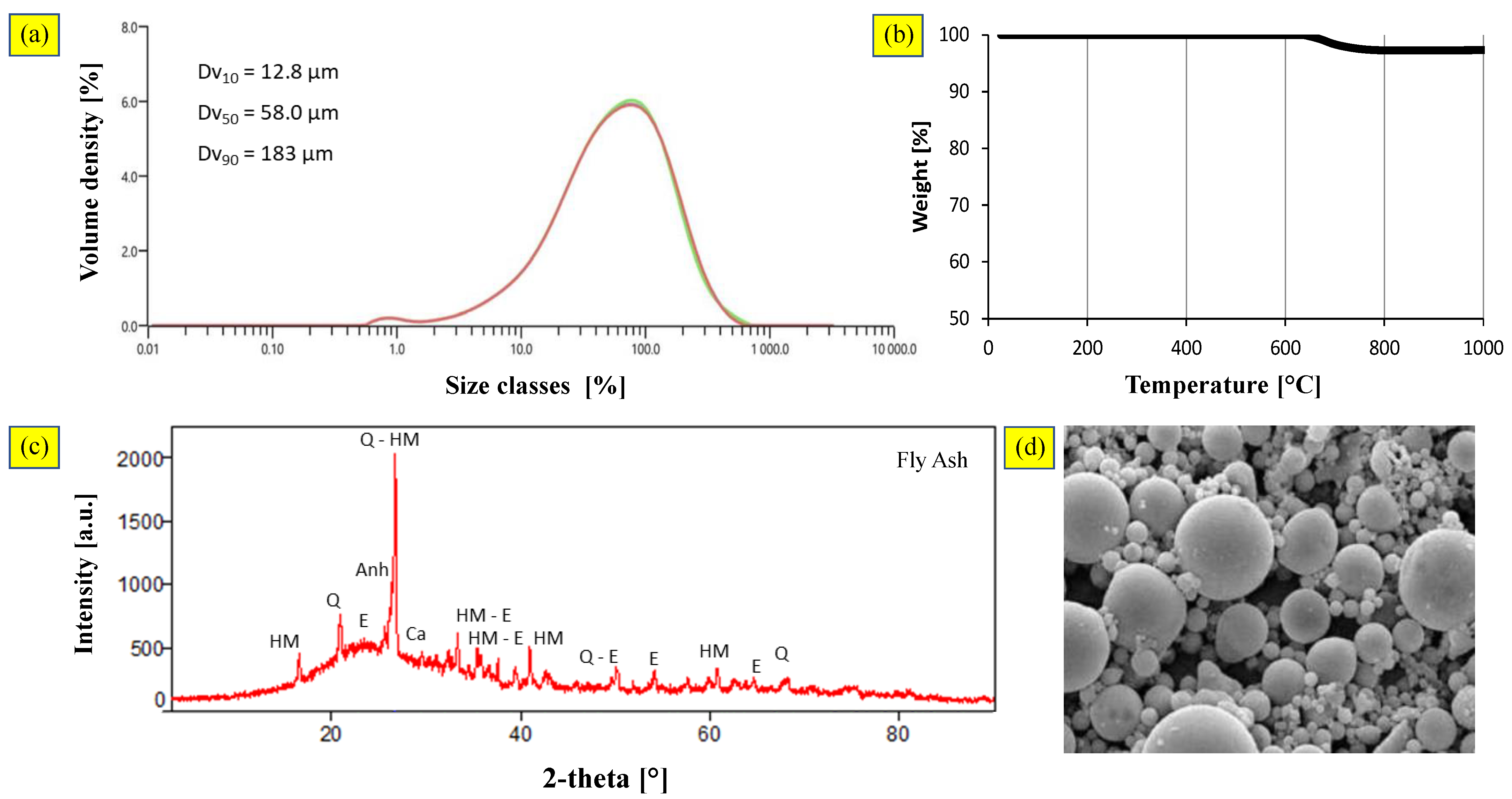
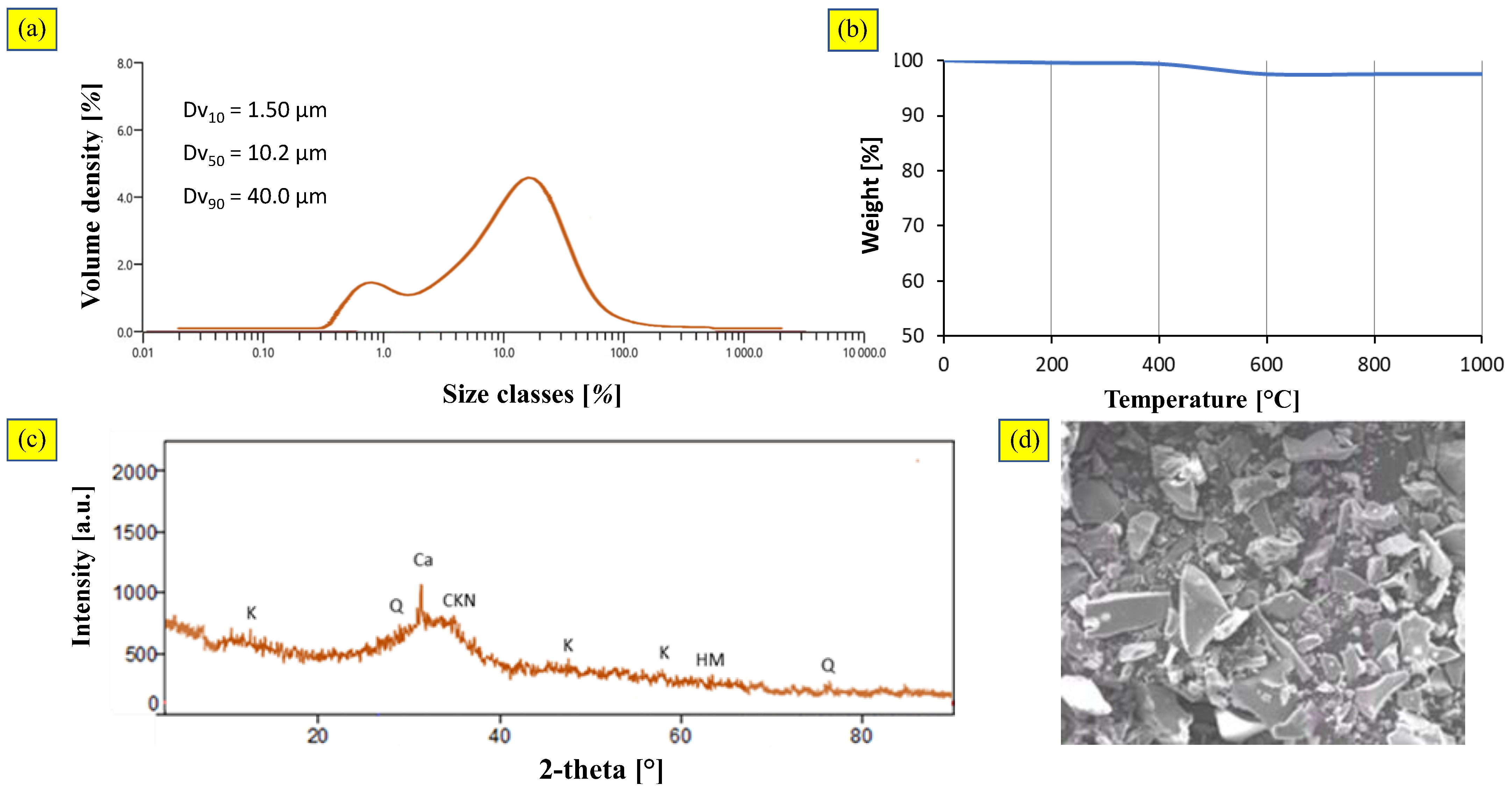
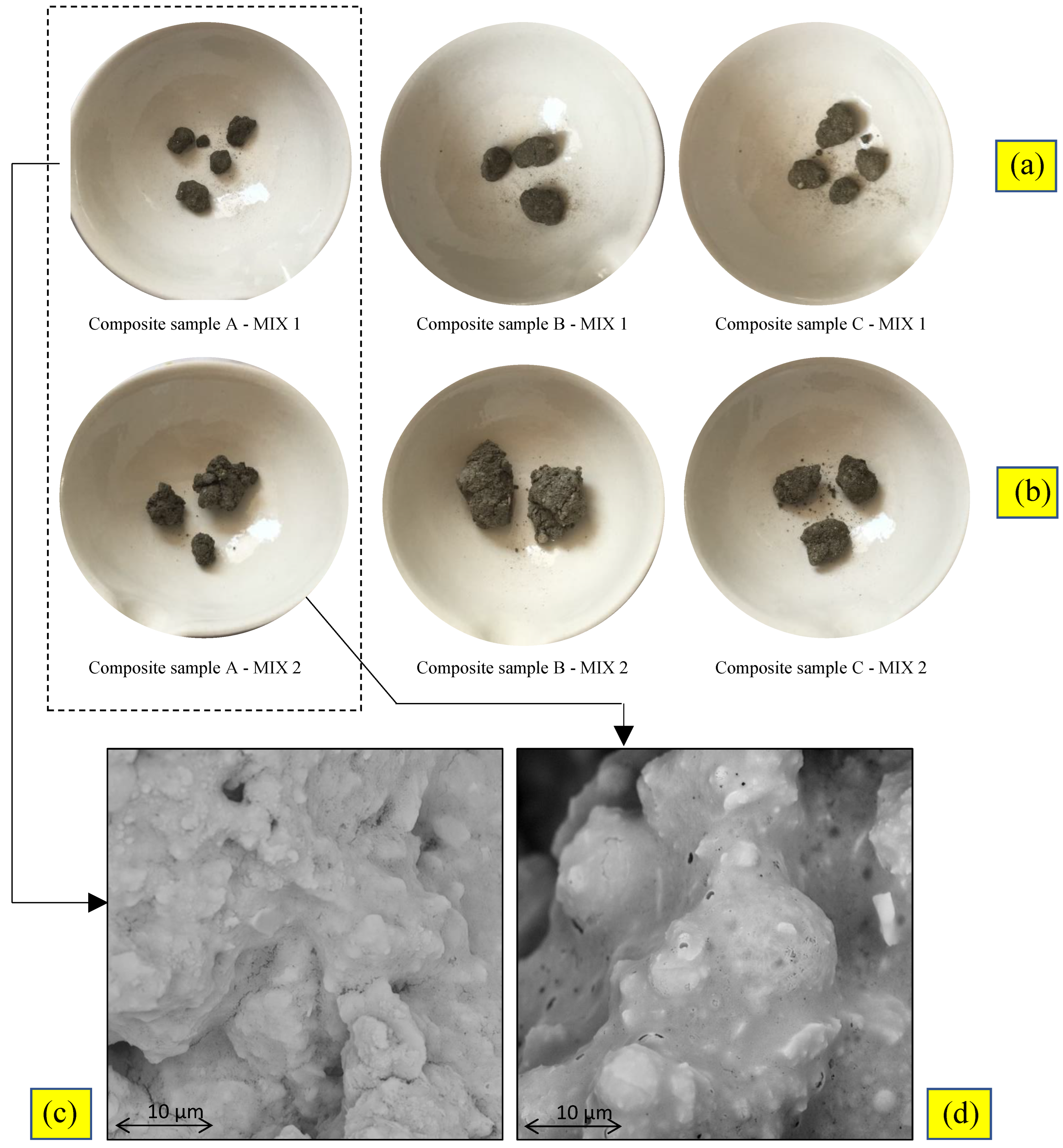
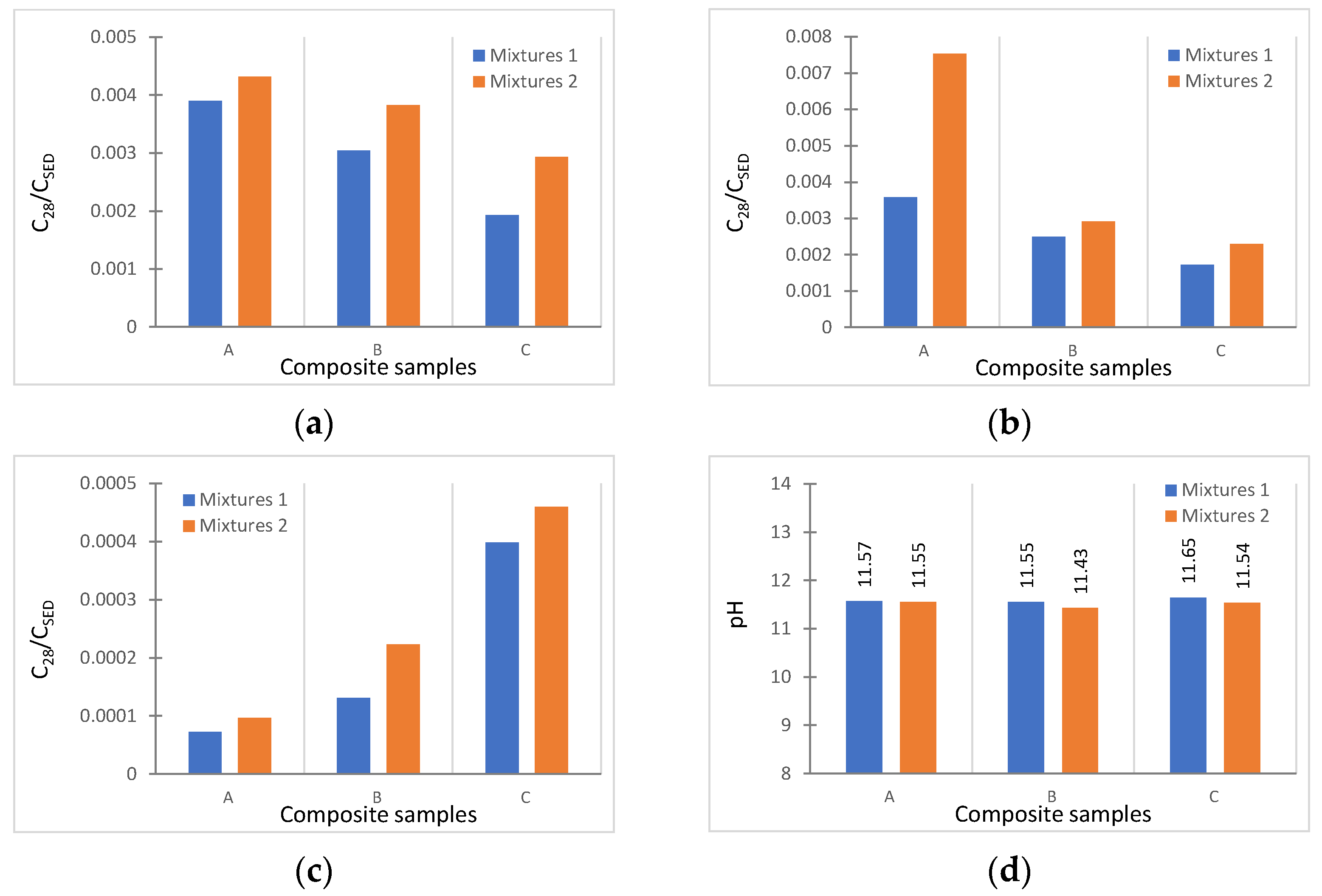
| Mix | Activator Solutions | Geopolymer Precursors | Water | Fluidifier | Sediment | |||
|---|---|---|---|---|---|---|---|---|
| Na2SiO5 | NaOH | H2O | CFA | BFS | ||||
| 1 | 9.8 | 1.0 | 2.0 | 31.2 | 5.2 | 7.2 | 2.0 | 41.6 |
| 2 | 11.4 | 1.8 | 2.6 | 31.2 | 5.2 | 5.2 | 1.0 | 41.6 |
| Unit | Natural Sample | Limit Value | ||||||||||
|---|---|---|---|---|---|---|---|---|---|---|---|---|
| SP3 | SP4 | SP6 | SP7 | SP9 | SP11 | SP12 | SP14 | SP16 | SP17 | |||
| Chemo-Physical parameters | ||||||||||||
| pH | u. pH | 9.1 | 8.9 | 9.1 | 9.2 | 9.2 | 9.2 | 8.9 | 8.8 | 9.1 | 9.3 | - |
| Eh | mV | −109.5 | −100.9 | −106.5 | −115.8 | −114.6 | −117.8 | −98.2 | −100.9 | −116.9 | −122.7 | - |
| MC | % | 50.83 | 52.0 | 50.6 | 20.2 | 51.8 | 53.8 | 58.4 | 65.1 | 51.8 | 54.2 | - |
| OM | % | 19.90 | 23.4 | 19.4 | 20.2 | 17.1 | 18.8 | 12.9 | 23.7 | 18.5 | 17.5 | - |
| Ash | % | 29.27 | 24.6 | 30.0 | 59.6 | 31.1 | 27.4 | 28.7 | 11.2 | 29.7 | 28.3 | - |
| GF | % | 4.80 | 20.68 | 12.87 | 13.69 | 3.96 | 7.41 | 31.76 | 18.43 | 14.39 | 7.47 | - |
| SF | % | 12.20 | 44.16 | 14.87 | 27.72 | 4.28 | 15.61 | 21.97 | 33.37 | 12.23 | 14.76 | - |
| PF | % | 83.00 | 35.16 | 72.26 | 58.59 | 91.76 | 76.98 | 46.27 | 48.20 | 73.38 | 77.76 | - |
| Inorganic contaminants | ||||||||||||
| As | mg/kg | 11.6 | 31.7 | 48.4 | 65.2 | 9.2 | 13.3 | 13.4 | 19.0 | 11.8 | 18.3 | 20.0 |
| Be | mg/kg | 0.7 | 0.8 | 1.2 | 1.0 | 1.0 | 1.1 | 0.6 | 0.9 | 0.7 | 1.5 | - |
| Cd | mg/kg | 0.4 | 2.5 | 0.9 | 1.0 | 0.5 | 0.5 | 0.5 | 1.3 | 0.4 | 0.6 | 1.00 |
| Cr | mg/kg | 54.5 | 81.8 | 80.8 | 78.0 | 75.2 | 71.6 | 43.3 | 65.3 | 57.1 | 76.7 | 160.0 |
| Co | mg/kg | 6.5 | 8.4 | 9.9 | 11.1 | 8.5 | 7.00 | 4.9 | 7.1 | 5.5 | 7.9 | - |
| Cu | mg/kg | 53.5 | 172.1 | 121.2 | 131.9 | 58.4 | 64.6 | 62.9 | 117.8 | 55.3 | 80.2 | 45.0 |
| Pb | mg/kg | 102.5 | 314.6 | 241.3 | 392.0 | 50.2 | 94.0 | 57.9 | 106.7 | 74.8 | 126.7 | 50.0 |
| Hg | mg/kg | 4.2 | 8.1 | 14.3 | 24.0 | 1.2 | 3.5 | 1.5 | 2.5 | 2.6 | 5.9 | 0.80 |
| Ni | mg/kg | 31.9 | 40.6 | 50.1 | 57.2 | 48.9 | 37.5 | 26.8 | 44.2 | 30.4 | 41.8 | 100.0 |
| V | mg/kg | 56.7 | 64.0 | 105.8 | 75.0 | 73.6 | 77.1 | 62.0 | 103.2 | 59.9 | 84.4 | - |
| Zn | mg/kg | 146.3 | 541.5 | 430.8 | 464.2 | 116.2 | 193.8 | 206.9 | 423.8 | 159.0 | 222.7 | 110.0 |
| Organic contaminants | ||||||||||||
| ΣPAH | µg/kg | 2159 | 11,652 | 6552 | 5810 | 1263 | 922 | 714 | 3172 | 1902 | 4515 | 4000 |
| ΣPCB | µg/kg | 277 | 3163 | 22,253 | 19,283 | 2331 | 794 | 607 | 2345 | 1660 | 3184 | 190 |
| Unit | Composite Sample (Average ± St. Dev) | Limit Value | |||
|---|---|---|---|---|---|
| A | B | C | |||
| Chemo-Physical parameters | |||||
| pH | pH unit | 9.1 ± 0.5 | 9.1 ± 0.3 | 9.0 ± 0.4 | - |
| Eh | mV | −111.5 ± 2.9 | −114.0 ± 2.2 | −105.3 ± 2.6 | - |
| MC | % | 44.2 ± 0.5 | 29.4 ± 0.8 | 58.4 ± 0.9 | - |
| OM | % | 20.3 ± 0.5 | 18.4 ± 0.8 | 18.2 ± 0.9 | - |
| Ash | % | 35.5 ± 0.5 | 42.2 ± 0.8 | 23.4 ± 0.9 | - |
| GF | % | 13.7 ± 1.5 | 5.4 ± 1.5 | 21.5 ± 1.5 | - |
| SF | % | 25.4 ± 1.5 | 10.7 ± 1.5 | 22.5 ± 1.5 | - |
| PF | % | 60.9 ± 1.5 | 83.9 ± 1.5 | 56.0 ± 1.5 | - |
| Inorganic contaminants | |||||
| As | mg/kg | 40.5 ± 0.5 | 11.5 ± 0.4 | 15.0 ± 0.3 | 20.0 |
| Be | mg/kg | 1.0 ± 0.1 | 0.9 ± 0.1 | 0.7 ± 0.1 | - |
| Ca | mg/kg | 1.2 ± 0.1 | 0.5 ± 0.1 | 0.7 ± 0.1 | 1.00 |
| Cr | mg/kg | 79.2 ± 2.4 | 65.1 ± 1.6 | 54.3 ± 0.9 | 160.0 |
| Co | mg/kg | 9.3 ± 0.5 | 7.3 ± 0.1 | 5.8 ± 0.4 | - |
| Cu | mg/kg | 127.4 ± 4.6 | 58.9 ± 1.6 | 78.7 ± 2.9 | 45.0 |
| Pb | mg/kg | 268.7 ± 1.8 | 82.4 ± 1.1 | 79.8 ± 1.4 | 50.0 |
| Hg | mg/kg | 13.0 ± 0.2 | 3.0 ± 0.5 | 2.2 ± 0.6 | 0.80 |
| Ni | mg/kg | 47.4 ± 1.3 | 39.4 ± 1.7 | 33.8 ± 1.8 | 100.0 |
| V | mg/kg | 82.3 ± 1.8 | 69.1 ± 1.9 | 75.1 ± 1.5 | - |
| Zn | mg/kg | 664.8 ± 1.6 | 152.1 ± 1.1 | 263.2 ± 1.8 | 110.0 |
| Organic contaminants | |||||
| ΣPAHs | µg/kg | 7130 ± 70 | 1450 ± 65 | 1930 ± 83 | 4000 |
| ΣPCBs | µg/kg | 11,950 ± 55 | 1135 ± 40 | 1535 ± 45 | 190 |
| Leaching Characteristics of Granules | |||||||
|---|---|---|---|---|---|---|---|
| Mix | Sample | Parameter | As (µg/L) | Cu (µg/L) | Hg (µg/L) | Pb (µg/L) | Zn (µg/L) |
| 1 | A | Leachate concentration | 158 ± 6 | 554 ± 26 | <LOD | <LOD | 30 ± 1 |
| Environmental goals (a) | ✗ | ✗ | ✓ | ✓ | ✓ | ||
| B | Leachate concentration | 35 ± 14 | 147 ± 19 | < LOD | <LOD | 20 ± 1 | |
| Environmental goals (a) | ✓ | ✓ | ✓ | ✓ | ✓ | ||
| C | Leachate concentration | 29 ± 1 | 136 ± 10 | <LOD | <LOD | 65 ± 1 | |
| Environmental goals (a) | ✓ | ✓ | ✓ | ✓ | ✓ | ||
| 2 | A | Leachate concentration | 175 ± 18 | 957 ± 29 | <LOD | <LOD | 40 ± 1 |
| Environmental goals (a) | ✗ | ✗ | ✓ | ✓ | ✓ | ||
| B | Leachate concentration | 44 ± 2 | 172 ± 20 | <LOD | <LOD | 34 ± 1 | |
| Environmental goals (a) | ✓ | ✓ | ✓ | ✓ | ✓ | ||
| C | Leachate concentration | 44 ± 2 | 181 ± 10 | <LOD | <LOD | 75 ± 1 | |
| Environmental goals (a) | ✓ | ✓ | ✓ | ✓ | ✓ | ||
| Physical Characteristics of Granules | |||||||
| Mix | Sample | Parameter | Density (kg/m3) | Porosity (%) | WAC (%) | AIV (%) | |
| 1 | A | Test results | 1800 ± 53 | 9.17 ± 0.30 | 5.05 ± 0.05 | 32.75 ± 0.12 | |
| Technical goals (b) | ✓ | ✓ | ✓ | ✓ | |||
| B | Test results | 1830 ± 55 | 4.27 ± 0.15 | 2.27 ± 0.02 | 34.46 ± 0.13 | ||
| Technical goals (b) | ✓ | ✓ | ✓ | ✓ | |||
| C | Test results | 1840 ± 55 | 3.32 ± 0.10 | 1.64 ± 0.01 | 34.83 ± 0.12 | ||
| Technical goals (b) | ✓ | ✓ | ✓ | ✓ | |||
| 2 | A | Test results | 1810 ± 53 | 11.86 ± 0.35 | 6.56 ± 0.05 | 31.43 ± 0.12 | |
| Technical goals (b) | ✓ | ✓ | ✓ | ✓ | |||
| B | Test results | 1837 ± 55 | 7.06 ± 0.20 | 3.85 ± 0.03 | 33.21 ± 0.13 | ||
| Technical goals (b) | ✓ | ✓ | ✓ | ✓ | |||
| C | Test results | 1852 ± 56 | 4.44 ± 0.15 | 2.40 ± 0.02 | 33.56 ± 0.12 | ||
| Technical goals (b) | ✓ | ✓ | ✓ | ✓ | |||
Disclaimer/Publisher’s Note: The statements, opinions and data contained in all publications are solely those of the individual author(s) and contributor(s) and not of MDPI and/or the editor(s). MDPI and/or the editor(s) disclaim responsibility for any injury to people or property resulting from any ideas, methods, instructions or products referred to in the content. |
© 2023 by the authors. Licensee MDPI, Basel, Switzerland. This article is an open access article distributed under the terms and conditions of the Creative Commons Attribution (CC BY) license (https://creativecommons.org/licenses/by/4.0/).
Share and Cite
Todaro, F.; Colangelo, F.; De Gisi, S.; Farina, I.; Ferone, C.; Labianca, C.; Petrella, A.; Cioffi, R.; Notarnicola, M. Recycling of Contaminated Marine Sediment and Industrial By-Products through Combined Stabilization/Solidification and Granulation Treatment. Materials 2023, 16, 2399. https://doi.org/10.3390/ma16062399
Todaro F, Colangelo F, De Gisi S, Farina I, Ferone C, Labianca C, Petrella A, Cioffi R, Notarnicola M. Recycling of Contaminated Marine Sediment and Industrial By-Products through Combined Stabilization/Solidification and Granulation Treatment. Materials. 2023; 16(6):2399. https://doi.org/10.3390/ma16062399
Chicago/Turabian StyleTodaro, Francesco, Francesco Colangelo, Sabino De Gisi, Ilenia Farina, Claudio Ferone, Claudia Labianca, Andrea Petrella, Raffaele Cioffi, and Michele Notarnicola. 2023. "Recycling of Contaminated Marine Sediment and Industrial By-Products through Combined Stabilization/Solidification and Granulation Treatment" Materials 16, no. 6: 2399. https://doi.org/10.3390/ma16062399
APA StyleTodaro, F., Colangelo, F., De Gisi, S., Farina, I., Ferone, C., Labianca, C., Petrella, A., Cioffi, R., & Notarnicola, M. (2023). Recycling of Contaminated Marine Sediment and Industrial By-Products through Combined Stabilization/Solidification and Granulation Treatment. Materials, 16(6), 2399. https://doi.org/10.3390/ma16062399














